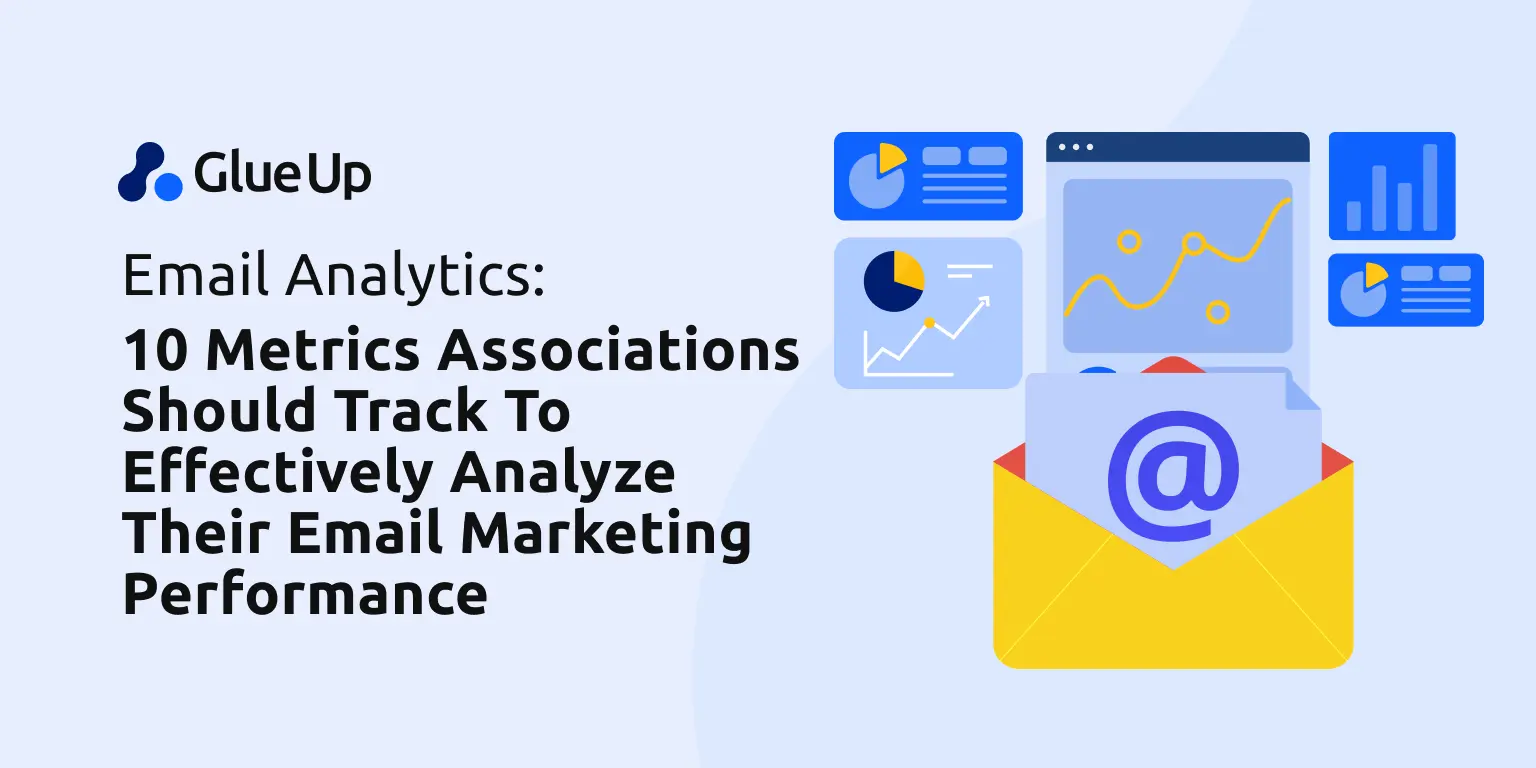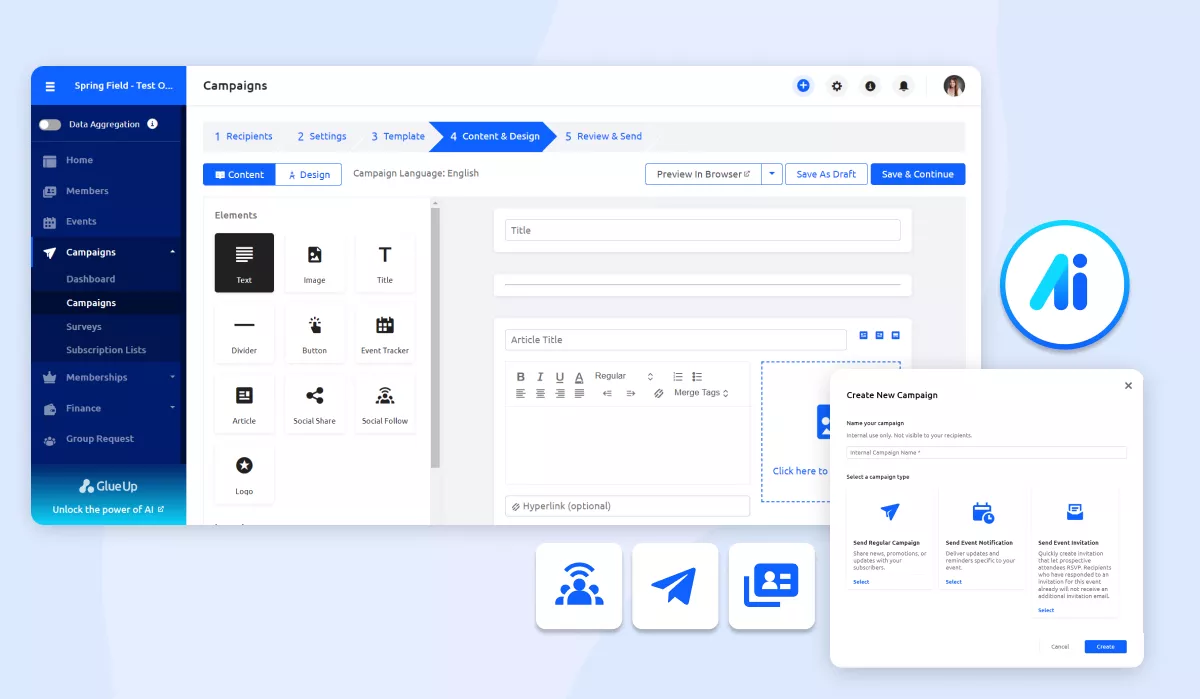
Email marketing plays a major role in promoting any business or association, as 87% of brands endorse its significance to business success. However, the crux of leveraging email marketing lies in understanding and analyzing its performance.
It's not just about sending bulk emails; it's about making sure these emails achieve the desired outcomes. Therefore, this blog will cover the metrics essential for evaluating the success of your email marketing campaigns.
From open rates to click-through rates and conversions, we'll guide you through the metrics that matter, helping you comprehend the true performance of your email marketing efforts and how to optimize them for better results.
Key Takeaways
- The detailed exploration emphasizes the importance of tracking specific email marketing metrics such as Click-Through Rate (CTR), Open Rate, Conversion Rate, Bounce Rate, and List Growth Rate.
- The choice of metrics to track should align with an association's specific goals, whether they are increasing brand visibility, generating leads, converting subscribers to members, or maintaining a healthy email list.
- The discussion on the latest email marketing benchmarks provides a valuable context for associations to measure their campaign performance against industry standards.
- Highlighting the best day to send marketing emails signifies the importance of timing in email marketing success.
- Glue Up is presented as a comprehensive solution that addresses the complexities of email marketing through a suite of features. These tools collectively empower associations to streamline their email marketing processes, create more engaging content, and achieve better engagement and growth.
Key Questions Associations Should Ask to Analyze Email Marketing Performance

If you're aiming to assess the impact of your email marketing campaigns, it's important to focus on several crucial questions first:
- What percentage of your emails are successfully delivered to recipients' inboxes?
- How many people open your emails?
- How effective are your calls-to-action (CTAs) in encouraging recipients to take action?
- How does your email campaign's performance align with industry standards?
However, remember that the answers to these questions can only be obtained through a thorough analysis of your campaign metrics, as metrics offer the precise figures needed for accurate evaluation.
Email Marketing Metrics Associations Need to Track

The most important metrics that associations need to track to analyze the performance of their email marketing campaigns are:
1. Clickthrough Rate
The Click-Through Rate (CTR) measures how many email recipients click on the links within your email. When you send an email to your subscriber list, which often contains links to your products or website, this rate helps you understand how many people visited those links from your email.
To calculate the CTR, divide the total number of clicks on the links by the total number of people in your email list and then multiply by 100. For instance, if you email a list of 50,000 people and 1,000 people click on the links, the CTR would be 2%.
This percentage indicates the effectiveness of your email in encouraging recipients to engage further with your content.
How Valuable Is a Clickthrough Rate?
The importance of the Click-Through Rate (CTR) in email marketing is evident from the fact that 34% of marketers track this metric for the emails they send, making it one of the top metrics to monitor.
However, this widespread tracking highlights the metric's value in understanding how effectively an email engages recipients and motivates them to click on external links; the higher the CTR, the better the campaign performance will be.
A high CTR indicates a successful email campaign and demonstrates the content's ability to resonate with the audience and encourage them to take further action.
2. Open Rate
According to HubSpot, the open rate is the second most tracked metric by marketers, accounting for 31% of their analysis of campaign performance. The open rate is a straightforward concept: It measures the percentage of recipients who opened your email out of the total number of people to whom the email was sent.
How Valuable Is Your Email Open Rate?
Since the open rate determines the effectiveness of your email in compelling your members to open it when it lands in their inbox, it essentially acts as the first impression of your campaign.
Basically, a high open rate suggests a positive first impression; if it's low and recipients don't open the email, the chances of them clicking on links inside the email or making a purchase from you will decrease significantly.
From this perspective, the open rate is an important metric. It sets the stage for the subsequent actions recipients might take, impacting the overall success of your email marketing efforts.
3. Conversion Rate
Although it ranks third, the conversion rate is a critical metric that measures how many recipients took the desired action you requested.
For example, if you sent an email with a survey link, the conversion rate would be determined by the number of people who clicked on the link and then filled out the survey. Every recipient who completes the form is considered a conversion.
How Valuable Is Your Conversion Rate?
This rate determines how many leads you generate, making it quite valuable. While the open rate and click-through rate (CTR) are important, the conversion rate truly translates to the actual performance of your email marketing campaigns.
If you intend to generate more leads and have a strong conversion rate, you're heading in the right direction. If not, you need to optimize your email campaigns. Marketers believe that the conversion rate is the real metric that defines a campaign's success.
It provides a direct insight into how effectively your emails convert potential interest into tangible actions or leads, reflecting your email marketing efforts' true impact and efficacy.
4. Bounce Rate
The bounce rate indicates the number of emails that went undelivered. For instance, when you send bulk emails, such as 25,000, and around 2,000 fail to land in the recipients' inboxes, those undelivered emails contribute to your bounce rate. If 2,000 emails out of 25,000 sent are undelivered, the bounce rate would be 8%.
There are two types of bounce rates to consider:
- Soft Bounce: Occurs when an email reaches the recipient's email server but is bounced back before it lands in the inbox. Reasons for soft bounces include a full mailbox, a temporarily unavailable server, or a message that is too large.
- Hard Bounce: This signifies a permanent reason an email cannot be delivered, such as invalid addresses, a non-existent domain name, or an unknown recipient. To preserve a healthy sender reputation, it's important to regularly clean your email list of addresses that result in hard bounces.
How Valuable Is a Bounce Rate?
However, the bounce rate doesn't directly define your campaign goals, but it's still necessary to identify why your emails are being undelivered. A soft bounce may result in the email eventually landing once the issue on the recipient's side gets resolved.
Conversely, in the case of hard bounces, having a high number of emails consistently going undelivered could flag you as a spammer from the perspective of Internet Service Providers (ISPs).
Therefore, this metric is important as it impacts not only your immediate email deliverability but also your long-term sender reputation and the effectiveness of your email marketing strategies.
5. List Growth Rate
The list growth rate indicates the trajectory of your growth in terms of email or newsletter subscribers, revealing whether you are consistently gaining new subscribers or losing existing ones.
Calculating the list growth rate involves simple mathematics: Take the number of new subscribers and subtract the number of unsubscribers or spam complaints. Then, divide this result by the total number of recipients in the list and multiply by 100.
How Valuable Is Your List Growth Rate?
The list growth rate is a crucial metric that ideally needs to be positive, considering that statistics reveal that 22.71% of an email list decays within just one year, out of which 20.19% were found to be invalid emails. Implementing effective strategies is mandatory to counteract this natural decay and maintain, if not grow your subscriber base.
You must proactively improve this rate; otherwise, your list will continue to shrink. Therefore, it is equally important to monitor this metric closely and understand its implications.
6. Email Sharing/Forwarding Rate
The email sharing/forward rate measures how recipients forward or share your email with others, whether with friends, by posting on their social media handles, or by presenting the email as an example.
Essentially, it calculates the ratio of people you sent the email to against the number of those who clicked on the share button.
How Valuable Are Email Sharing and Forwarding Rates
Tracking the email sharing/forward rate is important because it can directly contribute to gaining new subscribers. When recipients share your content with others, you will likely acquire new subscribers through these referrals. Therefore, this metric is a key indicator of your email's virality or appeal.
High sharing or forwarding rates suggest that your message resonates significantly with recipients, motivating them to spread the word. This expands your email's reach beyond the initial mailing list, potentially boosting engagement and overall impact.
7. Overall ROI
ROI, or Return on Investment, is arguably the most sought-after metric. If ROI is strong, it generally indicates that your strategies are effective. However, if ROI is underperforming, it indicates a deeper analysis of other metrics to identify where improvements can be made.
In simple terms, ROI measures the return you get from the amount you've invested into your email campaigns, or how much revenue you've generated from the money spent on these campaigns. Overall, it evaluates the efficiency and profitability of your email marketing, providing a clear picture of how well your investments are turning into tangible gains.
How Valuable Is ROI?
The ROI metric is undeniably important, as it largely determines the success of email campaigns. If your ROI figures look good, your campaign is on the right track, and issues with other metrics might not be as concerning.
Basically, a strong ROI makes other metrics like CTR (Click-Through Rate) and conversion rates secondary; while they are important for diagnosing campaign health, they don't have the same weight if the ROI is favorable.
Conversely, if the ROI is not up to par, then even strong performance in other areas, such as CTR and conversion rates, may not compensate for the shortfall.
Conclusively, email marketing strategies revolve around optimizing ROI, highlighting its primary role in defining the overall success of your email marketing efforts.
8. Unsubscribe Rate
The unsubscribe rate is the metric that tracks how many people opt out of your emails after opening them. However, it's not always a straightforward indicator of disinterest. Many recipients who continue to receive your brand's messages might ignore your emails without opening them, yet remain subscribed.
In such cases, these subscribers are still counted in your metrics but don't actively engage with your content. Therefore, the unsubscribe rate doesn't always provide a clear picture of your email campaign's effectiveness like Click-Through Rate (CTR) does.
How Valuable Is an Unsubscribe Rate?
While the unsubscribe rate doesn't directly define your campaign targets, it's still better to monitor it closely, especially in relation to your email list growth rate. Maintaining a healthy balance is essential; a high unsubscribe rate can counter your efforts in growing your list.
Therefore, tracking and analyzing this metric is important to understand the reasons behind the unsubscribes. It could indicate issues with content relevance, or email frequency.
Still keeping an eye on the unsubscribe rate and investigating the causes behind it, you can make informed adjustments to your email strategy to reduce this rate and assure a positive trajectory for your list growth rate.
9. Spam Complaints
Spam complaints occur when recipients mark your emails as unwanted, signaling ISPs (Internet Service Providers) or email service providers to redirect these emails to the spam folder. While emails getting undelivered is one issue, having your emails marked as spam is a more significant concern.
Spam affects the immediate deliverability of your messages and harms your sender's reputation over time. A high rate of spam complaints can lead ISPs to judge your content as irrelevant, resulting in a greater number of your emails being automatically filtered into spam folders. Thus, spam reduces the effectiveness of your email marketing efforts.
How Valuable Are Spam Complaints?
Spam complaints are often considered negligible and neglected, but an excessive number can lead to trouble. Monitoring this metric is important, as a significant number of complaints can result in ISPs blocking your future emails.
Specifically, if the spam complaint rate reaches a threshold of 0.2%, you receive a warning, and at a rate of 0.5%, your account could face suspension. This demonstrates the importance of monitoring spam complaints and taking proactive steps to reduce them.
10. Best Day to Send Marketing Emails
According to HubSpot, Tuesday is the best day to send a marketing email, while Sunday is the worst. However, this can vary from one campaign to another, and it's beneficial to analyze your specific data to understand which day your emails perform best.
Monitoring and recording the performance of your emails across different days allows you to direct your email marketing strategy according to your audience's preferences and behaviors. Furthermore, you can optimize your email send times for maximum engagement, ensuring that your marketing efforts are as effective as possible.
How Valuable Is the Best Day to Send Marketing Emails?
While it may not be widely discussed, the timing of your email dispatch plays a significant role in its success. Sending your email on a day when people are more inclined to read it can lead to better engagement, even if the content is average.
Conversely, even the best-written emails may go unnoticed if they're sent on days when recipients are less likely to engage with their emails. This timing can have a considerable impact on the overall success of your campaign.
How to Know Which Email Metrics to Track, Based on Your Goals

Numerous metrics are available to track, but not all of them may be necessary for your specific needs. It's important to analyze and focus on the metrics that align with your association's brand awareness goals.
However, these goals can differ significantly from those of other associations and may change over time. To evaluate your strategies effectively, you must tailor your metrics to match your unique objectives.
Subscriber List Growth Rate
If you aim to showcase your brand to a broader audience, it's important to monitor the list growth rate closely. The higher the growth rate, the more visibility your brand will achieve. This metric reflects how effectively your marketing efforts are expanding your reach, attracting new subscribers, and ultimately improving your brand's presence in the market.
Monitoring and optimizing for a positive list growth rate can help you achieve your objective of increasing brand awareness, as it directly correlates with how many people are introduced to and engage with your brand through email marketing.
Unengaged Subscribers
Monitoring unengaged subscribers is also important when considering the list growth rate, as both metrics are interrelated. Continuously sending emails to recipients who show no interest in your content results in what's known as "graymail."
Graymail consists of emails that aren't outright spam but are largely irrelevant to the recipients. This decreases engagement rates, potentially harming your email deliverability and sender reputation.
Managing your list to identify and address unengaged subscribers either by re-engagement campaigns or by removing them from your list can improve the health of your email marketing efforts and verify that your list growth rate reflects a genuinely interested and engaged audience.
Number of New (or Total) Leads Generated
If your focus shifts to generating leads rather than increasing new subscribers, your email campaigns should prominently feature calls to action (CTAs) designed to convert recipients into leads.
In this case, sending emails with clear, compelling CTAs becomes a priority. These CTAs guide subscribers to take the desired action, such as filling out a form, signing up for a webinar, or downloading a resource.
Consequently, tracking the conversion rate becomes more important than other metrics. Overall, this means you would be more focused on tracking conversion metrics to evaluate how well your CTAs are performing in turning recipients into leads.
Lead-To-Member Conversion Rate
If your aim is to convert leads or recipients into members of your organization, the Lead-To-Member Conversion Rate becomes a crucial metric to track. Your interest in this metric means that your email campaigns must be strategically designed with calls to action (CTAs) that encourage this conversion.
Emails would feature CTAs such as "Become a Member," "Sign Up," or other invitations that directly encourage recipients to join your organization. Tracking how effectively these CTAs convert leads into members allows you to fine-tune your messaging, offer value that resonates with your audience, and ultimately increase your association's membership.
Navigating Email Marketing Metrics

When monitoring email metrics, it's essential to adopt a tailored approach. Your focus should be on the metrics that directly translate to your association's goals rather than on analyzing every metric available.
Playing smart means prioritizing the insights that align with your goals, whether increasing membership, boosting engagement, or increasing the event registration rate.
Concentrating on the key performance indicators that matter most to your objectives can help you make informed decisions swiftly and direct your email marketing strategy toward achieving your desired results.
The Latest Email Marketing Benchmarks/Metrics for Associations
Industry benchmarks for email campaigns serve as a guide to measure the performance of your initiatives. If your emails achieve results within the range of these benchmarks, then you can be confident that your strategy is on the right track.
However, if your results fall outside these benchmarks, it indicates a need for optimization of your campaigns. It's important to note that these benchmarks are not static; they evolve over time, with some metrics experiencing increases while others may decrease.
This fluctuation is influenced by various factors such as changes in consumer behavior, advancements in technology, and shifts in marketing trends. Therefore, exploring and understanding the latest benchmarks for the email marketing in 2024 is essential to ensure your campaigns remain effective and competitive in the changing landscape.
- Email volume experienced a 4.3% increase in 2024 compared to 2023.
- The average open rate of emails across all industries worldwide stands at 18%.
- The average unsubscribe rate is maintained below 1% across most industries.
- The average click-through rate (CTR) for all emails is 1.33%, applicable to all industries around the globe.
- 55% of emails are opened on mobile devices.
- Emails with subject lines between 20 and 60 characters tend to achieve the highest open and click-through rates.
Optimize Your Email Campaigns with Glue Up

Glue Up, the first AI-powered All-in-One Association Management Software, provides a comprehensive suite of features designed to transform your email marketing efforts. Here's a closer look at what it has to offer:
- Glue Up AI Copilot: The AI Copilot revolutionizes the way you create content. It takes the hassle out of brainstorming and drafting by offering features like custom prompts, tone of voice selection, and automatic trimming to ensure your content is engaging and concise.
- Drag & Drop Email Designer: This tool simplifies the design process with an intuitive drag-and-drop interface. It makes it easy to craft visually appealing emails without needing advanced design skills.
- Contact Management: Efficiently manage your contacts in one place. Organize, segment, and keep track of your audience details to ensure your campaigns reach the right people.
- Email Templates: Get access to a variety of pre-designed email templates that cater to different needs and occasions. These templates provide a solid foundation for your campaigns, saving you time and effort.
- Email Marketing Automation: Automate your email campaigns to ensure timely and relevant communication with your audience. From welcome emails to follow-ups, automation helps maintain engagement without manual intervention.
- Smart Lists: Utilize smart lists to segment your audience based on their behaviors, preferences, and engagement levels. This feature allows for more targeted and effective email marketing campaigns.
- Email Statistics: Gain valuable insights into the performance of your email campaigns with comprehensive statistics. The track opens, clicks, unsubscribes, and more to measure success and inform future strategies.
- Bounce Management: Maintain the health of your email list with bounce management. Identify and address delivery issues to improve your overall email deliverability.
- Customizable Dashboards: Personalize your view with customizable dashboards that highlight the metrics and information most important to you. Keep track of your email marketing performance at a glance.
Glue Up's email marketing capabilities are designed to streamline your workflow, enhance your content creation, and optimize your engagement strategy, making it easier than ever to achieve your association's goals. Book a demo to discover how Glue Up can transform your email marketing and help you achieve remarkable engagement and growth.



